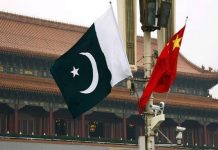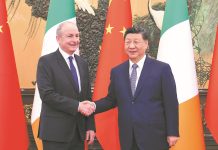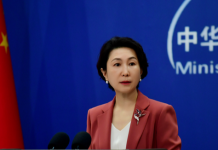
‘Hey, you’re too tall. We need to fill you up! Don’t you like it?!” Amid the cacophony of jangling silver trinkets, traditional songs and the deep sonorous blasts of the lusheng, mouth organs fashioned from 6-meter-long bamboo pipes, this author crouches down and attempts to elegantly sip bowl after bowl of rice wine offered by a spirited women of the local Miao ethnic group. Spoiler alert: Graceful consumption wasn’t exactly the end result.
It was a crisp early January morning, and yours truly was about to do a deep dive into Miao ethnic culture while shooting for China Daily’s Potside Chats series. Our destination was Hongyang Village, a Miao town tucked snugly amid rolling hills and veiled in mist in Taijiang County of southwest China’s Guizhou Province.
Guizhou, known for its great peaks and being the only region in China without plains, is the beating heart of the Miao legacy, home to around 4 million members of the ethnic group. The Miao, tracing their lineage back over 5,000 years, can also be found across Yunnan, Sichuan, Hubei and Hunan provinces, as well as in Southeast Asia, where they are known as the Hmong.
Sauntering along the slippery cobblestones, the mist lifted to reveal the scene of smoke lazily curling from the chimneys of the small dark wooden houses dotting the mountain side, oozing a sense of unpolished appeal and mystery.
Strolling among the houses and laneways, it was impossible not to notice just how many young tourists were joining us in exploring the village.
Given the bucolic beauty, it’s no wonder flocks of young Chinese have found themselves drawn to explore this town and the county’s other hidden gems.
Then my inner Miss Marple emerged: How did this new fascination with ethnic cultures come about among Chinese millennials and Gen Zs?
I was thirsty for more.
Putting yourself out there
The key to stepping into the world? Infrastructure.
Infrastructure development in Guizhou kicked off in the early 21st century as part of a broader push to boost connectivity and progress in China’s remote regions. Bridges—especially important in Guizhou, roads, railways… the works. All aim to connect secluded hamlets in less developed areas with the rest of the country, opening up new pathways for economic and social development. The Chinese Government has, after all, pursued a “no ethnic group should be left behind” policy and is continuously rolling out new initiatives to nurture these once forgotten enclaves under the national rural revitalization strategy—props when and where due.
This strategy, introduced in 2017, promotes the economic prosperity and overall development of rural areas. It builds on the success of the nationwide poverty alleviation campaign, which succeeded in eradicating absolute poverty in late 2020. The strategy involves developing rural industries and improving the living standards of rural residents, who, especially in the southern and southwestern regions, more often than not belong to smaller ethnic groups.
But the most interesting infrastructural evolution might be China’s almost unparalleled digital development. Over the years, the country has invested heavily in the telecommunications sector to ensure widespread coverage and connectivity—from bustling metropolises to remote villages.
And beyond the realm of data streams and signal strength lies a phenomenon that has permeated every corner of Chinese society: social media.
China’s social media landscape is undeniably one of the world’s most pervasive, with platforms like the Weixin superapp, Weibo (the country’s X equivalent), Douyin (the Chinese version of TikTok), Xiaohongshu (a wildly popular lifestyle and e-commerce app) and Bilibili (a YouTube-like platform mainly targeting Gen Zs) collectively boasting hundreds of millions of users.
They are not just communication tools, but also avenues for accessing entertainment, e-commerce and news. Douyin, for example, had over 750 million daily active users and Xiaohongshu over 200 million monthly active users as of late 2023, according to Statista.com—just to provide a glimpse into the magnitude of China’s social media.
The platforms have evolved into potent instruments for China’s ethnic groups, thrusting their heritage from the shadows into the spotlight of economic opportunity through enchanting short videos, livestreams, photos and other media.
In the past four to five years, roughly coinciding with the domestic commercial rollout of 5G technology in 2019, the groups have captivated China’s younger generations, millennials and Gen Zs hungry for authenticity and diversity, and spellbound by the medley of colorific customs brought to life on their screens.
Fascination: ignited.
On Douyin, the hashtag “ethnic culture” had 6 billion related posts as of June 12. And circling back to where we started: the hashtag “Guizhou Taijiang” boasted 100 million posts on the platform.
What’s more, the call for media products celebrating ethnic cultures has grown louder over the years. As of late May, one of China’s TV hits of the year was To the Wonder. A series set amid the rugged landscapes of China’s remote northwest, it’s a story about Kazak nomads that has domestic viewers raving—the related hashtag had garnered 4.3 billion posts on Douyin as of June 9.
But this symphony of connectivity and culture today also resonates far beyond the confines of the screen.
Pastoral preachers
It appears that many poster children of the urban jungle are now becoming preachers of all that is pastoral.
In the lead-up to both the recent May Day and Dragon Boat Festival holidays, from May 1 to 5 and from June 8 to 10, respectively offering five days and three days of respite, young Chinese delved into a digital treasure trove of travel recommendations on Xiaohongshu and Bilibili. In the digital realm, whispers of hidden charms echoed, drawing attention to places like the small, rather isolated county of Anji in Zhejiang Province, where people can lose themselves in the lush bamboo forests—and a budding coffee culture percolates. Taijiang also stirred excitement online, with many netizens discussing the “magic of its local Miao customs.”
Judging from the social grids, young urbanites are yearning for rural tranquility combined with contemporary lifestyle experiences. Their wanderlust is a reaction to the copy-paste cultural format that has been applied to a host of revamped rural towns.
These explorers seek more than just a change of scenery; they crave immersive experiences. From participating in traditional festivals to mastering local crafts and cuisines, this is where China’s ethnic groups hold an advantage.
If you are throwing a little soirée and decide to whip up some sour fish soup and sticky rice cakes, two Miao staples, and can regale your guests with the story of how and where you learned to cook them, you’re sure to earn some culinary kudos.
Destinations like Yunnan, Guangxi Zhuang Autonomous Region and Guizhou, known for their ethnic diversity, perfectly cater to the ever-more-refined palate of the young vacationer and have subsequently become popular travel spots in recent years.
Not much of a chef? Dazzle your guests with pictures from your ethnic travel shoots. From Xizang and Xinjiang Uygur autonomous regions to Guizhou, everywhere you turn in China, tourists bedecked in traditional local ethnic garb and sporting impeccable makeup are striking poses for the professional lens. The results? Glossy material.
Fashionation
Many of China’s traditional ethnic fashions have become sources of artisanally treasured inspiration for contemporary fashion designers and brands, which have been taking a leaf out of the extensive fashion and beauty pages written by these population groups.
The legend of Mother Butterfly, for example, is preserved in Miao song and embroidery and inspired Shenzhen-based fashion designer Zhao Huizhou, who featured the motif at a Miao art exhibition she curated during Milan Fashion Week in September 2023. She brought along Shi Chuanying, a Miao embroiderer from Taijiang who had created many of the patterns on display. Speaking about her creative zeal, Zhao told this author in Hongyang Village that, “Fashion needs a cultural imprint; I love the Miao culture, because its embroidery is like ‘wearing history books on the body’.” The designer has shown at Milan Fashion Week more than 10 times, most recently in February, with her catwalk collections telling the front row more about the Miao story through the language of contemporary fashion. “The group’s embroidered motifs are the threads of life itself, weaving together the daily rhythms, the rites of passage and the records of the community lore,” Zhao continued.
For Zhao, the current young(er) fascination with all things ethnic is a matter of “rekindled cultural confidence”—we’re talking guochao. Literally meaning “national wave,” guochao refers to products, from fashion to food, packing traditional Chinese cultural elements. This wave is among the most significant currents in the contemporary young cultural narrative since it was “officially” popularized by Chinese athletic apparel brand Li Ning at New York Fashion Week in early 2018.
Zhao isn’t the only one turning to China’s ethnic tapestry for inspiration. Shanghai Fashion Week regularly features brands and designers infusing their creations with some ethnic panache. And in 2022, Queen Bey (aka American entertainer Beyoncé) wore a cloak, created by post-00 couture designer Yuan Qiqi, inspired by the shawl worn by the Yi people in southwest China, recognizable by its over-the-top contour, during her Renaissance album cover shoot. Chinese netizens were over the moon.
Beauty brand Florasis (known as Huaxizi in China), headquartered in Hangzhou, Zhejiang, has been raking in young Chinese (and international) fans since its inception in 2017. Known for its affordable products, Florasis consistently seeks inspiration from the cultural wealth of the nation’s ethnic communities. The brand’s “Impression of Miao” limited edition collection in 2020 reproduced the ethnic group’s gilding crafts. The “Nomadic Glam” limited series in late 2023 paid homage to the nomadic lifestyle of the Mongolian ethnic culture.
All these products sold like hotcakes.
A combination of cultural confidence and contemporary convenience has turned the younger Chinese generations into Curious Cathies, eager to explore the hidden wonders their homeland holds. Enticed by what they see on their smartphone screens, they want to seek refuge from the urban neon so many of them reside in and take a big gulp of all the traditional culture China still has to offer.
“Ethnic” equals “euphoric.” –The Daily Mail-Beijing Review news exchange item





